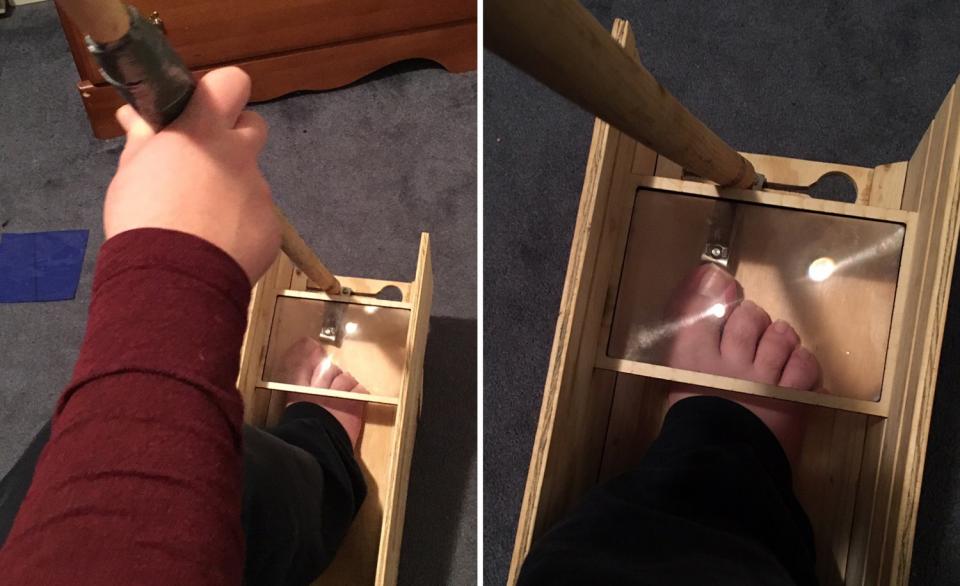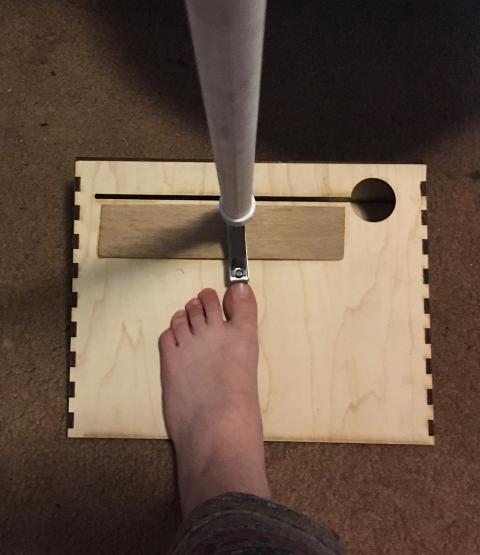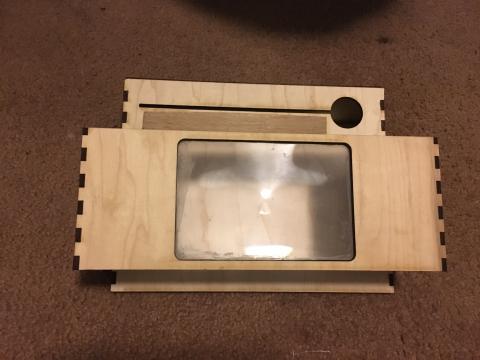By: beccahelbraun | Posted: June 26, 2017 | Updated: April 5, 2023
Recent Ithaca College Occupational Therapy Student Rebecca Helbraun discovers the challenge that toenail cutting poses for older adults; does some research; and invents, designs, and prototypes a new solution. She shares her journey here.
“Simple” Problems Can be Very Important
Throughout my life, it has been my intention to do good, offer help, and be a resource for whoever needs. Because of my inner drive and experiences growing up, my life has lead me to the field of Occupational Therapy (OT). OT is a profession in which therapists aim to enable clients to participate in meaningful ‘occupations’ or activities of daily living.
Based on my studies to become an OT, I have come to understand many problems that exist in the world due to consequences of natural aging, as well as health conditions including disease, disability, and other illness or disorder. As individuals age, they may have problems that are as complex as pursuing independent transportation when they are unable to safely drive independently, or determining ways they can speak to others, when they are unable to produce autonomous speech.
Through my personal interactions and continued studies, I discovered that while many human problems seem simple, they actually pose complex dilemmas for individuals who try to solve them. Furthermore, society often forgets about these problems that seem ‘inherently simple,’ resulting in drastic challenges for individuals who can’t get past them to achieve their daily tasks.
Reaching & Cutting Toenails: It’s a Real Problem
One class challenged me to think critically about these human problems, in hopes of provoking us students to find ways solve them.
As I thought about these issues, I became aware of one particular problem that many individuals have. This is the inability to reach and cut one’s toenails independently. Many believe that simple daily tasks such as cutting toenails are not a big deal. Yet, while this task may seem to be a small dilemma, it poses a big problem for much of the world population including older adults, individuals with arthritis, pregnant women, and those who are obese.
Thus, cutting toenails is a bigger issue than one may imagine. First, overgrown toenails can be detrimental to one’s health. Additionally, one of the most frequent causes of older adult falls is secondary to overgrown toenails. Further, overgrown toenails can cause irritation to the feet and can result in toenails falling off. These conditions can cause infection, and in drastic cases, amputation of the toe, foot, or leg.
It is especially important to acknowledge the occurrence of this problem in the United States because, as a country, our culture values people who are independent. As a result, many individuals choose not to ask for help with these everyday tasks because they are too embarrassed, or feel that they are a burden to others.
It is necessary to recognize that as the Baby Boomer Generation grows, the number of people unable to cut their toenails will continue to increase.
It is true that if these older adults wish to receive professional assistance for self-care tasks such as this, they must pay for visits to professional podiatrists. In drastic cases, older adults may need to be relocated to nursing homes due to falls or foot infections, to receive daily, and skilled individualized care.
Therefore, solving this problem is essential to give individuals a new sense of independence, while preventing injury and decline.
The Toenail Clipper Design Project
My universal toenail clipper project began as a class group design project.
As we students put our brains together, we aimed to come up with the best solution to this large problem. We began by searching for solutions that already existed. We also considered user information, such as those presented on the Tech-enhanced website, courtesy of the Longevity Explorers.
After searching online, through a plethora of sources, our group found the few products that were on the market. Each of these products were fairly similar in that they all had toenail clippers on long metal structures to reach the toenails. Several of them had magnifiers attached to see the foot at a greater distance. Additionally, many of the clippers had hand squeezing mechanisms, allowing for an individual hand squeeze on the top part of the metal structure, resulting in a clip at the bottom.
Our group, as well as the users, found several flaws with these types of models.
We knew that there could be a better way to create a clipping mechanism, to reduce any strains on the internal muscles of the hand. Additionally, we believed that there could be improvements made to increase the precision of the toenail clipper.
All the current models we found were on a long stick, yet had no way to be secured to ensure that there would not be a safety hazard of cutting the skin near the toenails. Thus, these existing options seemed to have a commonality in that they had problematic mechanisms to cut the toenail and had a sense of instability when following through and cutting the toenail.
Prototype Design # 1
To combat these shortfalls, my group sought out ways to better secure the toenail clipper, thereby increasing precision.
We also tried to find new and easier ways to mechanically cut the toenails. In order to find the most efficient way to do this, we sought advice from physics experts at our college and at the local maker space. This interdisciplinary group, put all minds together to come up with the best design. The result was successful in solving the main problem, by making the clip mechanically simpler.
The first prototype: Prototype I, had the toenail clipper placed on a long wooden pole that reached down to the foot, which was connected to a foot plate.
The foot plate was an angular attachment that allowed for a locking mechanism for the toenail clipper, and an easier way to execute the cutting mechanism. The clipping worked in a way that once the clipper was locked in place, a user would simply use their large arm muscle to bring the wooden pole towards their body in a downward motion, thereby achieving a successful toenail cut. The locking mechanism that allowed the cutter to attach to the foot plate provided an increased sense of precision, allowing the user to be sure they cut their toenail and not their skin.
Attaching a magnifier to the device added to a successful outcome, by allowing the user to have a closer view of their foot when cutting their toenails.

This two component design of the toenail clipper was a great solution for us. Yet, after initial testing we found that this prototype still had flaws.
Prototype I proved difficult to use. The clipper part of the device did not quite reach up to the tip of the toenail and therefore could not necessarily achieve the cutting mechanism it was intended to do. Further, the prototype was bulky, heavy, and inconvenient. It was a product that was made as a school project, that ended up being rushed to finish.
So, while this product was a great idea, it needed more work in order to achieve its goal.
Prototype Design # 2

Despite the group assignment ending, I still believed that the product had great potential to help individuals with this ongoing human problem. I did not want to leave this project with a prototype that was not fully successful, and believed there was a way to create an even better prototype. As a result, I began my own adventure to create Prototype II.
I worked with other helpers from the local maker space who I knew could assist me with the product. The Ithaca Generator was a huge help for me.
This creative team showed me how to create something out of nothing using a toenail clipper, PVC, wood, and nails. With the help of my new friends, I learned how to create a prototype the way I wanted and believed it needed to be. I went back to the drawing board, listed pros and cons, and eventually printed, glued, and screwed my product together.
After completing the second version, I was overjoyed when I saw that it was successful. This new version was much smaller and more convenient for the potential user. It was the shape I wanted it to be and was much lighter than the previous version.
Prototype II also adjusted for the height differences of toenails on each toe.
Another benefit to this version was that the toenail clipper was removable from the PVC pole, allowing it to be less bulky than Prototype I.
This product still had a magnifier, however it was disconnected from the main foot plate, allowing both items to have increased mobility and making sure it would not get in the way of an individual’s leg when they were clipping their toenails.
This was a product I was proud of. Prototype II was usable, light, and well made, especially for a novice such as myself.

Prototype Design #3
I am still looking to make Prototype III in the future.
While I am pleased with the current version, I believe that further action can be taken to make the product even better and more user friendly.
Still, I believe that this is a unique product that can potentially go to market to help individuals with this need. I would love to create change through this product, allowing individuals to have increased independence to cut their toenails without needing the assistance of others.
I believe that someday, this product can be on the market to help people and change lives, providing independence for those who cannot perform this essential, sometimes overlooked occupation.
Would You Like To Help Rebecca?
When thinking about this product’s next step, I am interested in some assistance.
In order to make this product truly successful, I require those experienced with funding and marketing to help this universal toenail cutter become a reality. I believe that with collaboration, this product can be out on the market and make its way to individual’s homes, thereby creating independence for those who are in need.
To contact Rebecca, use this contact form and mention you are reaching out to Rebecca.
*Disclosure: The research and opinions in this article are those of the author, and may or may not reflect the official views of Tech-enhanced Life.
If you use the links on this website when you buy products we write about, we may earn commissions from qualifying purchases as an Amazon Associate or other affiliate program participant. This does not affect the price you pay. We use the (modest) income to help fund our research.
In some cases, when we evaluate products and services, we ask the vendor to loan us the products we review (so we don’t need to buy them). Beyond the above, Tech-enhanced Life has no financial interest in any products or services discussed here, and this article is not sponsored by the vendor or any third party. See How we Fund our Work.



I love the idea of the
I love the idea of the toenail clipper. One suggestion I have is how to stabilize the foot from wiggling side to side? How far does a person reach to adjust location of clippers?
A point about medicare and podiatrist, visiting elders in their homes, they are plenty of people who are stiff in the hips and are not Medicare eligible. I am just over 55 but my hip is limited enough and it’s very hard to reach my toes I look forward to hearing how the project goes.